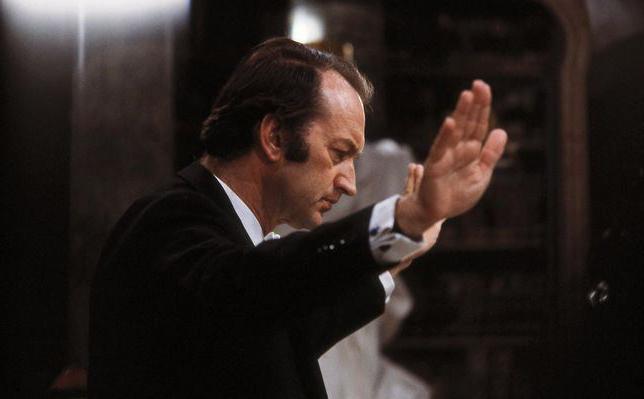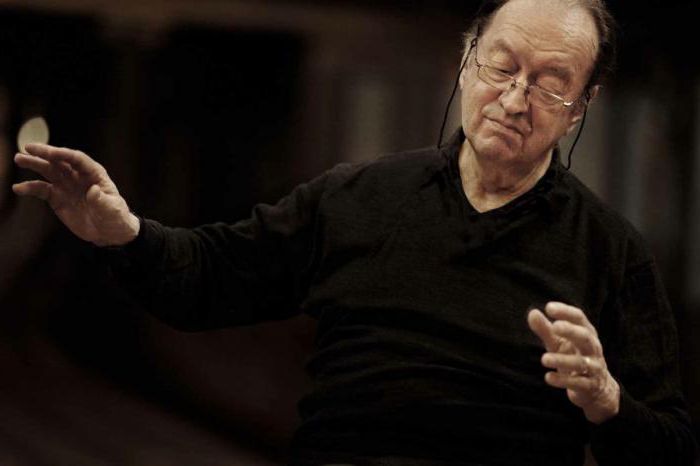In the early days of spring 2016, the greatest Austrian cellist, musicologist and conductor Nikolaus Arnonkur passed away. Collaborating with major European orchestras, he took the time to popularize authentic performance and teach at the world famous Salzburg Conservatory Mozarteum. For his services, Arnoncourt took fifth place in 2010 in the ranking of outstanding conductors of all time, compiled by BBC Music Magazine. In addition, the name of the musician forever entered the Hall of Fame of the British classical music magazine Gramophone.
Family of the future conductor
Nikolaus Harnoncourt (Nikolaus Arnoncourt) - conductor, whose name became a legend during his lifetime. He was born in Berlin in 1929 in a family belonging to a noble aristocratic family. From birth, the musician had the title of count, his full name sounded like Johann Nikolaus de la Fontaine d'Arnoncourt-Unferzagt. His mother, Countess Ladislaya von Meran, was the granddaughter of Archduke Johann of Austria, born of Emperor Leopold II and Maria Louise of Spain.
Father Nikolaus was called Eberhart de la Fontaine d'Arnoncourt-Unferzagt. He bore the title of count and was a native of an ancient Luxembourgish-Lorraine family. The ancestors of his paternal grandmother, Julia Mittrovskaya, lived in the Czech Republic. Since childhood, Eberhard dreamed of becoming a musician, but by the will of fate was forced to get a technical education. After graduation, he moved from Vienna to Berlin and got a job as a civil engineer. Here he married Countess von Meran, who subsequently bore him five children. In addition to them, Eberhard had two offspring from his first marriage.
Passion for playing the cello
When Hitler came to power in Germany in 1933, the entire Arnoncourt family moved to Graz, where the generic estate of Ladislai was located. Soon after the Anschluss of Austria, in 1939, their property was nationalized, and all the privileges that aristocrats enjoyed for a long time were taken away. Despite the difficult times, their children Eberhard and Ladislaya were raised in love and care. All of them were taught to play musical instruments, but only Nikolaus Arnoncourt subsequently became a musician. The conductor fell in love with cello from early childhood and did not want to part with it under any circumstances. One of his brothers, Philip, preferred religion to music and became a Catholic theologian, while the second, Franz, made a brilliant career as a lawyer.
Education, work in the Philharmonic Orchestra
After the war ended, Nikolaus entered the Vienna Conservatory, which he graduated in 1952. In his student days, the future conductor worked part-time by playing the cello in the orchestra of the Vienna State Opera. After graduating from the conservatory, the 23-year-old musician was noticed by Herbert von Karayan, the head of the Moscow Philharmonic Orchestra, and personally invited to his work. This could be called a real success, because it was extremely difficult to become a cellist at the Vienna Philharmonic. Arnoncourt Nikolaus subsequently recalled that 40 people claimed his place in the orchestra, but Karayan liked his way of behaving and he took him out of competition.

Work in the Vienna Philharmonic Orchestra brought Arnoncourt a solid income, touring around the world, regular participation in the prestigious Salzburg festival, respect and honor. However, this period in the life of Nikolaus cannot be called completely cloudless. Karayan, who personally invited a talented cellist to his orchestra, soon considered a competitor in him and began to pursue a policy of systematic persecution against him. It ended only in 1969, when the 40-year-old Arnoncourt quit the orchestra and set about creating a career as a conductor.
Marriage, having children
In 1953, the Austrian conductor Nikolaus Arnonkur, whose work is considered in this publication, married the violinist Alice Hoffelner, who studied with him at the conservatory. In 1954, the couple gave birth to a daughter, Elizabeth, who later became a famous opera singer. Having married, she took the name of her husband von Magnus. After the daughter of Arnonkurov 3 sons were born. A young family settled in a large house located in the Austrian Alps.
Creating your own ensemble
By the age of 25, Nikolaus Arnoncourt had a prestigious job, a devoted wife, a good home. It would seem that you can calm down and enjoy life. However, the cellist was not going to stop there. In 1953, he acquired a viola de gambo, an old baroque string instrument reminiscent of a cello. Having learned to play it, Nikolaus buys some more ancient instruments, after which, together with his wife and several friends, he establishes the Concentus Musicus Wien ensemble. The created team specialized in authentic performance of classical works of the XVI-XVIII centuries. It was the first ensemble in the world whose repertoire consisted of the musical heritage of the Baroque era. For 20 years, his rehearsals took place in the living room of the Arnonkurov house. In order to reproduce the sound of ancient musical works as accurately as possible, the team members had to spend a lot of time and study a huge number of scores.
The advent of popularity
Nikolaus Arnonkur was not sure of the success of his project, so he combined rehearsals with work in the Vienna Philharmonic Orchestra. However, to his surprise, the work of Concentus Musicus Wien became popular among art lovers, the period of active performances and tours began among musicians. Being on the wave of success, the ensemble concludes a lucrative contract with the well-known German company Telefunken and over the course of 15 years has recorded hundreds of Baroque musical works. Here are Purcell suites, and Bach sonatas, and the ancient operas of Rameau and Monteverdi.
Beginning of a conducting career
The work in the ensemble began to take so much time with Arnoncourt that he could no longer combine it with performances in the orchestra. Continuous conflicts with Karayan added fuel to the fire. Since the late 60s, the musician often performs with his ensemble as a conductor and no longer sees the point of being an ordinary cellist. Leaving the band of Karayan, he begins to conduct not only with Concentus Musicus Wien. In 1970, Arnoncourt brilliantly leads the orchestra in the production of the opera Return of Ulysses to the legendary La Scala Theater. After this performance, art fans realized that in the musical horizon, a new star lit up and her name - Arnoncourt Nikolaus.
Arnoncourt's creative activities in adulthood
For two decades, the conductor worked closely with the Dutch harpsichord player Gustav Leonhardt. As a result of this collaboration, the musicians were able to record the full cycle of Bach cantatas, which includes more than 200 works. In the late 80s, the Austrian conductor Arnonkur Nikolaus led orchestras in the best opera houses on the planet. In just 4 years (from 1987 to 1991), he managed to record all the works of Beethoven, Schubert and Mozart, to stage several operas in the Vienna Theater. The musician collaborated with the philharmonic orchestras of Berlin, Vienna and Amsterdam, performed together with such talented pianists as Lan Lan and Friedrich Gould. In subsequent years, Arnoncourt's repertoire expanded significantly. Towards the end of his life, he managed to stage almost all the works that aroused his interest. The conductor performed with musical compositions by Haydn, Vivaldi, Handel, Schumann, Mendelssohn, Offenbach, Wagner, Dvorak, Brahms and other classics. In addition to conducting, he found time to teach at the Mozarteum Conservatory, of which he has been an Honorary Doctor since 2008.
Nikolaus Arnoncourt: albums, publications and awards
You can get acquainted with the work of Arnoncur today thanks to his albums. Their number is difficult to count. A significant part of the albums was released together with the Concentus Musicus Wien ensemble, whose conductor has been the permanent leader.
The authorship of Arnoncourt owns numerous musicological publications published in many reputable music publications. You can read the articles of the famous conductor in the collection "My Contemporaries Bach, Mozart, Monteverdi", published in Russian in 2005.
For outstanding achievements in art, Nikolaus Arnoncourt was repeatedly awarded prestigious prizes. In 1997, the conductor was awarded the Robert Schuman Prize for the popularization of academic music. Subsequently, the work of Arnoncourt was awarded the Grammy and Kyoto Prizes , as well as the Leipzig Bach Medal.
Leaving Art and Death
Arnoncourt was conducting to a very old age. At 85, he remained active, full of strength and creative inspiration. His excellent physical form allowed him to withstand a busy concert schedule and close attention from journalists and art fans. Arnoncourt did not plan to retire; he had many plans for the future. However, the age took its toll, and on December 15, 2015 the conductor made an official statement on the completion of his creative career. The reason for such an unexpected decision for many was the deterioration of his health due to a serious illness.

Arnonkur died on March 5, 2016 in the Austrian town of Sankt Georgen im Attergau. In the last minutes of his life, his wife, children and grandchildren were with him. The great conductor and musician lived for 86 years. The popularity of Arnoncourt around the world was so great that all the major television channels, radio stations and newspapers on the planet reported his death. The heart of the outstanding conductor stopped beating, but his music will forever remain in the audio recordings, allowing future generations to enjoy the beauty of classical music in an authentic performance.